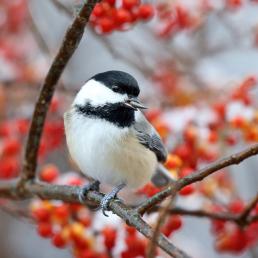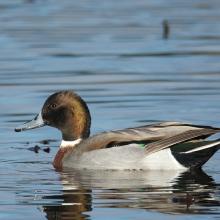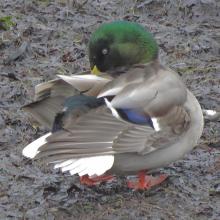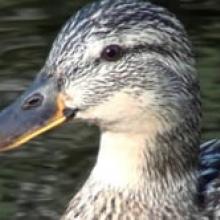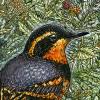

Join BirdNote tomorrow, November 30th!
Illustrator David Sibley and actor H. Jon Benjamin will face off in the bird illustration battle of the century during BirdNote's Year-end Celebration and Auction!
Even though it’s been known for many years that birds spit out caterpillars they find repellent, little research has been devoted to birds’ sense of taste. It wasn’t until the 1970s that a scientist found taste buds on the inside of a duck’s bill — more than 400 of them. An experiment with ducks — such as this Mallard — showed that when they picked up peas with the tips of their bills, they could easily discriminate between normal peas, which they happily gulped down, and peas that tasted unpleasant, which they rejected.
This show brought to you by The Bobolink Foundation.
BirdNote®
Birds Pass the Taste Test
Written by Bob Sundstrom
This is BirdNote.
[Mallard Calls http://macaulaylibrary.org/audio/133222]
Even though it’s been known for many years that birds spit out caterpillars they find repellent, little research has yet been devoted to birds’ sense of taste. And because birds have tough, bony beaks and hard, skinny tongues, it was just hard for experts to give birds much credit for tasting their food. So it wasn’t until the 1970s that a scientist found taste buds on the inside of a duck’s bill – more than 400 of them. [Mallard calls http://macaulaylibrary.org/audio/133222]
And an experiment with ducks showed that when they picked up peas with the tips of their bills, they could easily discriminate between normal peas, which they happily gulped down, and unpleasant tasting peas, which they rejected. [Mallard calls http://macaulaylibrary.org/audio/133222]
Taste buds have been studied in only a few bird species, so the field of inquiry is wide open. It is known that hummingbirds can taste different concentrations of sugar and that sandpipers can taste the presence of worms under a mudflat.
The fact that birds have far fewer taste buds than humans doesn’t necessarily mean their sense of taste is crude. As one Hollywood duck might put it…[Daffy Duck: That's ridiculous…ha ha ha ha… online recording]
For BirdNote I'm Mary McCann [Mallard calls http://macaulaylibrary.org/audio/133222]
###
Bird sounds provided by The Macaulay Library of Natural Sounds at the Cornell Lab of Ornithology, Ithaca, New York. Mallard calls [133222] recorded by Michael J Andersen.
BirdNote’s theme music was composed and played by Nancy Rumbel and John Kessler.
Producer: John Kessler
Executive Producer: Dominic Black
© 2015 Tune In to Nature.org May 2017 Narrator: Mary McCann
ID# taste-01-2015-05-05 taste-01
